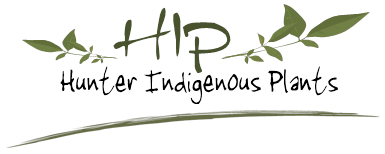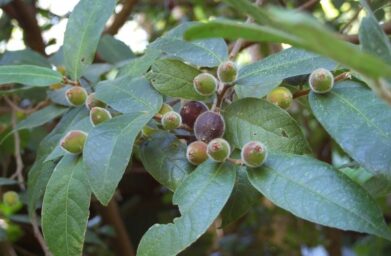Acacia longifolia (Sydney Golden Wattle)
A common hardy wattle, growing 3-4m tall, with golden yellow cylindrical flowers.
Uses: Aborigines roasted the pods to eat the seeds which are rich in nutrients. The flowers are edible, having a subtle sweet flavour which can be added to cakes.
Acmena smithii (Lilly Pilly)
A well known attractive small tree with fragrant white flowers and mauve berries.
Uses: The fruit is fleshy and sweet but is sometimes tart/ sour. The fruit is also made into a jam.
Alpinia caerulea (Native Ginger)
A fringe rainforest clumping plant with blue berries.
Uses: The blue fruits are edible? but have a slightly acid taste. The young tips taste like ginger.
Baeckea virgata (Heath Myrtle)
A shrub of sheltered places with numerous small white flowers.
Uses: The leaves are boiled to make a sweet tea.
Billardiera scandens (Apple Berry)
A slender twiner/ climber with pale yellow tubular flowers.
Uses: The cylindrical fruits when soft and ripe have a sweet, edible pulp.
Carpobrotus glaucescens (Pigface)
A succulent groundcover found on coastal sand dunes. The leaves are thick and fleshy, and the flowers are bright pink.
Uses: The juice from the leaves can be used to soothe insect bites.
Cissus hypoglauca (Native Grape)
A woody vine growing in or near rainforest. Leaves are arranged in 5’s in a palm shape.
Uses: The purple-black fruits are grape-like and edible.
Dianella caerulea (Blue Flax Lily)
An attractive clumping plant with blue flowers and blue berries.
Uses: The ripe fruits are edible.
Doryanthes excelsa (Gymea Lily)
A beautiful large tufted plant. The flowers grow on a stem which can be several metres high. The flowers are bright red and in large round clusters.
Uses: The long flower stems were roasted and eaten by Aborigines
Eustrephus latifolius (Wombat Berry)
A common tough twiner/ climber found near creeklines.
Uses: The orange fruits can be eaten but are tasteless. The underground tubers can also be eaten raw.
Ficus coronata (Sandpaper Fig)
A small tree growing along creeklines and near rainforest. The leaves are rough and sandpapery.
Uses: Aborigines used the leaves to smooth timber for tools, bowls and other useful items. The fruits are edible.


